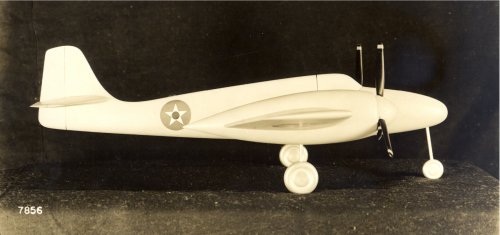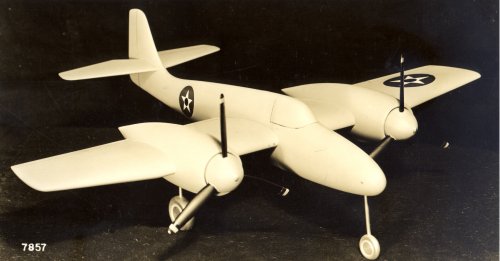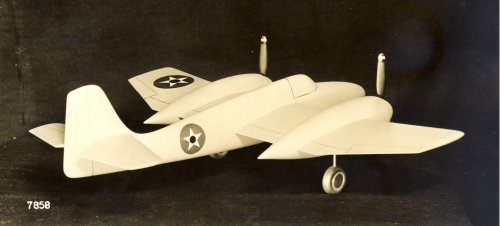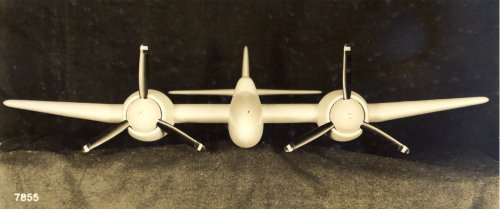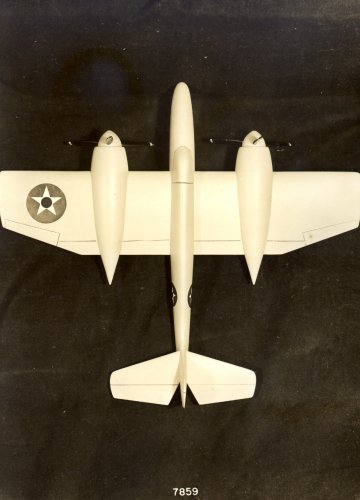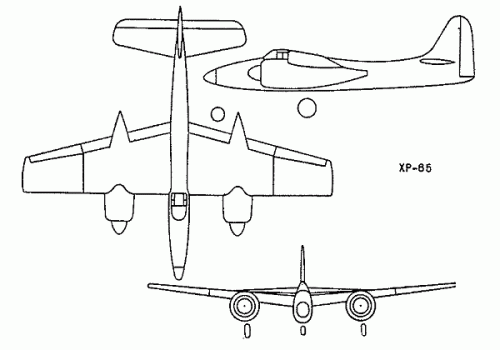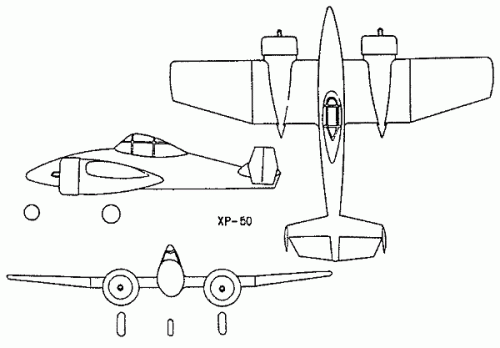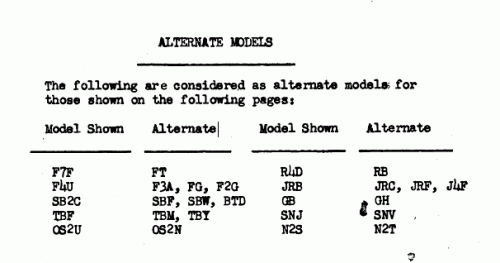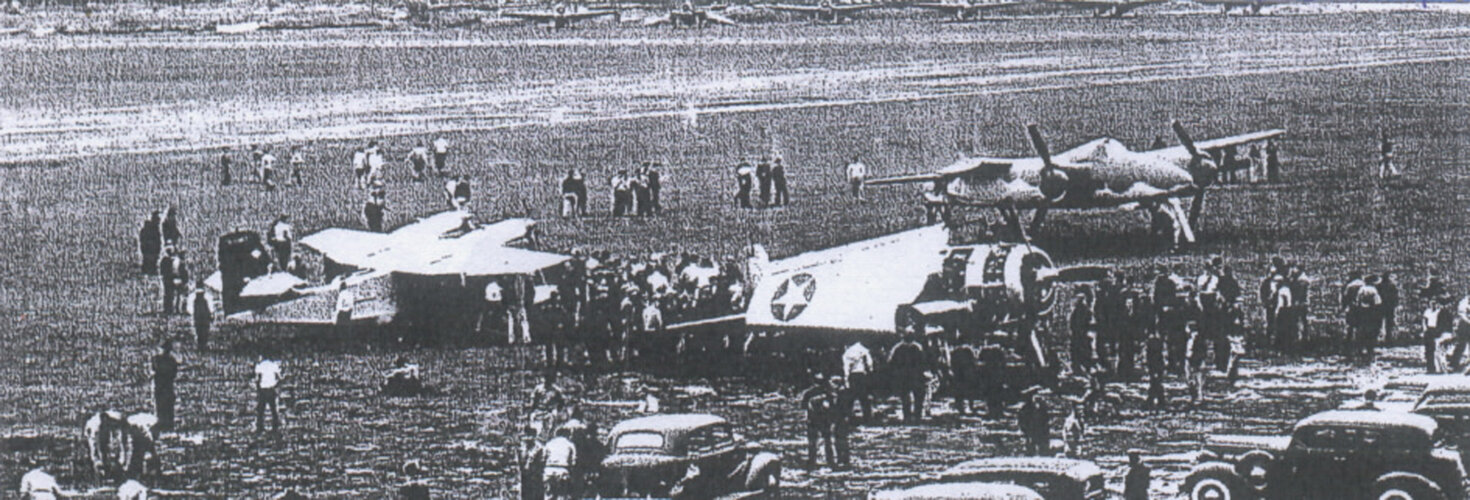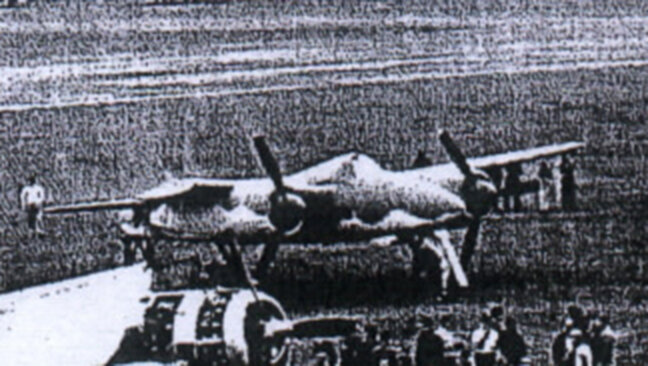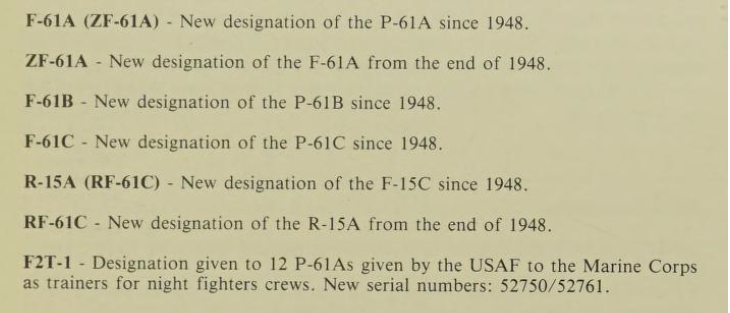Stumbled upon these pics on eBay. I'm posting a link to only 1 of 5 auctions showing various views. Tho I'm an F7F fan, I've never seen this design before. Very early design? The F7F relative, XP-65?
You are using an out of date browser. It may not display this or other websites correctly.
You should upgrade or use an alternative browser.
You should upgrade or use an alternative browser.
Grumman F7F very early model pics?
- Thread starter frank
- Start date
- Joined
- 25 July 2007
- Messages
- 3,861
- Reaction score
- 3,132
Stargazer2006 said:... wasn't the XP-65 a later design to the F7F?
The XP-65 and XF7F-1 were developed concurrently.
As to the identity of the model (and acknowledging that it's a photo of a model) . I'm wondering if there may be a clue in the markings.
Asymmetrical wing markings, fuselage cockade, and absense of tail stripes all suggest Army Air Corps sometime after the ACB's July 1940 markings memorandum. On the other hand, photos of F4F-3s in early 1941 show asymmetrical wing markings while later images of F4F-4s show symmetrical cockades. Both Wildcat variants show fuselage cockades and full tail stripes.
Does anyone know when the USN adopted asymetrical wing markings or exactly when the Navy got rid of the red tail stripes?
Hoo-2b-2day
ACCESS: Confidential
- Joined
- 27 February 2008
- Messages
- 65
- Reaction score
- 11
It would appear to be an early design study for what eventually became the G-51 (F7F) series and could be within the G-46 (XP-65) or G-49 (Proposed export fighter with two R-2600 engines)series. Note that the engines are mid-mounted on the wind of the model, while both the G-46 and G-51 the engines were underslung on the wings.
I copied this off the interweb but don't know where:
Grumman Design 51
Grumman submitted its proposal for Design #51 to the U.S. Navy on 24 March 1941 to meet the
sea service's longstanding desire for a twin-engine carrier fighter. That June the Navy
awarded a contract for two prototypes. With Grumman giving priority to development and
production of the F6F Hellcat, work on the new fighter was slow and the first official flight
did not occur until November 1943. Eventually the Navy procured 364 production versions of
the fighter, which was called the F7F Tigercat, including photoreconnaissance and night
fighter versions. They served primarily with the Marine Corps and saw combat in Korea.
Probably the same place I got the pictures...
Grumman Design 51
Grumman submitted its proposal for Design #51 to the U.S. Navy on 24 March 1941 to meet the
sea service's longstanding desire for a twin-engine carrier fighter. That June the Navy
awarded a contract for two prototypes. With Grumman giving priority to development and
production of the F6F Hellcat, work on the new fighter was slow and the first official flight
did not occur until November 1943. Eventually the Navy procured 364 production versions of
the fighter, which was called the F7F Tigercat, including photoreconnaissance and night
fighter versions. They served primarily with the Marine Corps and saw combat in Korea.
Probably the same place I got the pictures...
Attachments
- Joined
- 25 June 2009
- Messages
- 13,714
- Reaction score
- 2,875
Same pics, and another source that gives this as the Model G-51 and a proposal for Navy...
Could we have a 3-view of the XP-65 proposal for comparison?
(don't know anything about G-69, so if that exists in planform too, why not?)
Could we have a 3-view of the XP-65 proposal for comparison?
(don't know anything about G-69, so if that exists in planform too, why not?)
According to Corky Meyer's F7F monograph for Steve Ginter, Grumman proposed basically the same airplane—Design 51— to the Army Air Corps and the Navy, the former in January 1941 and the latter in March. The Army bought it as the XP-65 with a pressurized cockpit, and two 37 mm cannon in June but then canceled the procurement in January 1942. The Navy's version was unpressurized with four 20 mm cannon and four .50 caliber machine guns and ordered in May 1941 (Francillon states late June) as the XF7F.Stargazer2006 said:Same pics, and another source that gives this as the Model G-51 and a proposal for Navy...
Could we have a 3-view of the XP-65 proposal for comparison?
(don't know anything about G-69, so if that exists in planform too, why not?)
Grumman had been trying to interest the Army in a follow-on to its XP-50 (design 46 and a derivative of the XF5F). This resulted in the Design 49, with two each of Wright R-2600 engines, 20 mm cannons, and .50 caliber machine guns.
Update: According to Baugher, the XP-65 engines were to be turbo supercharged and the XF7F engines, mechanically supercharged and the XP-65 was to also have four .50 caliber machine guns. There is a three-view drawing of the XP-65 in Meyer's monograph (also labeled Model G-45 which was the XP-50) which appears to be identical to the XF7F except for the windscreen.
The model pictured above may be the Design 49 or for the XP-65 proposal.
I'll try to remember to look into this the next time I visit Grumman...
- Joined
- 25 June 2009
- Messages
- 13,714
- Reaction score
- 2,875
To summarize the various aircraft described in this page, we have:
G-34 = U.S. Navy XF5F-1 "Skyrocket"
G-41 = U.S. Army XP-50 "Skyrocket" (sometimes found as the "Tomcat")
G-46 = U.S. Army XP-65 ("Tigercat")
G-51 = U.S. Navy XF7F-1 "Tigercat"
The scale model aircraft that is depicted above is apparently an early portrayal of G-46, perhaps presented by Grumman to the Navy when the replacement of the crashed XP-50 was in order.
Here are two 3-view drawings of the XP-50 and XP-65 taken from Model Designation Army Aircraft, Twelfth edition (Report number TSEST-A7), published by Chief of Engineering Division, June 1946. In that official USAAF document, the former is clearly named as "Skyrocket", while the latter has no name.
G-34 = U.S. Navy XF5F-1 "Skyrocket"
G-41 = U.S. Army XP-50 "Skyrocket" (sometimes found as the "Tomcat")
G-46 = U.S. Army XP-65 ("Tigercat")
G-51 = U.S. Navy XF7F-1 "Tigercat"
The scale model aircraft that is depicted above is apparently an early portrayal of G-46, perhaps presented by Grumman to the Navy when the replacement of the crashed XP-50 was in order.
Here are two 3-view drawings of the XP-50 and XP-65 taken from Model Designation Army Aircraft, Twelfth edition (Report number TSEST-A7), published by Chief of Engineering Division, June 1946. In that official USAAF document, the former is clearly named as "Skyrocket", while the latter has no name.
Attachments
J
joncarrfarrelly
Guest
According to Grumman Aircraft since 1929 by Francillon, the XP-65 and F7F-1 were both Design 51, which was a single design that incorporated most features of Designs 46 and 49.
page 223: "Grumman's efforts were soon rewarded; the Army Air Forces ordered two XP-65 prototypes on 16 June, 1941,
and, two weeks later, the Navy awarded a contract for two F7F-1 prototypes. Sunsequently, however, both Services
concluded that a single design would not meet their specific requirements, and on 16 January, 1942, the Army dropped
out of the program to enable Grumman to optimize the design to satisfy naval requirements for twin-engined fighters
intended to operate from soon-to-be-ordered 45,000 ton Midway-class carriers and from land bases. Changes made
during the ensuing months were incorporated in the mock-up, which passed inspection in September 1942, and included
a switch from mid-mounted to shoulder-mounted wings."
Jon
page 223: "Grumman's efforts were soon rewarded; the Army Air Forces ordered two XP-65 prototypes on 16 June, 1941,
and, two weeks later, the Navy awarded a contract for two F7F-1 prototypes. Sunsequently, however, both Services
concluded that a single design would not meet their specific requirements, and on 16 January, 1942, the Army dropped
out of the program to enable Grumman to optimize the design to satisfy naval requirements for twin-engined fighters
intended to operate from soon-to-be-ordered 45,000 ton Midway-class carriers and from land bases. Changes made
during the ensuing months were incorporated in the mock-up, which passed inspection in September 1942, and included
a switch from mid-mounted to shoulder-mounted wings."
Jon
- Joined
- 25 June 2009
- Messages
- 13,714
- Reaction score
- 2,875
If it were so, then the scale model would probably be G-46, right?
I don't know what to make of these authors writing contradicting information. Some of them have to be wrong! Francillon is usually reliable, though... Thanks anyway.
I don't know what to make of these authors writing contradicting information. Some of them have to be wrong! Francillon is usually reliable, though... Thanks anyway.
Jos Heyman
ACCESS: Top Secret
- Joined
- 15 February 2007
- Messages
- 597
- Reaction score
- 53
In my experience it is very common that the 'classic' books by Rene Francillon and others of the same respectable caliber, have minor inaccuracies as, since they did their research, a lot of new information has come to light. You will agree that this is especially as the internet and forums like this, allow the sharing of information, including the June 1946 source that has been mentioned. Since the 1946 source pre-dates Rene Francillon work and seems to be an authentic source, we have therefore discovered and matched another piece of history. So I would agree, XP-65 = G-46.
But are we 100% clear that the model represents the G-46?
But are we 100% clear that the model represents the G-46?
- Joined
- 25 June 2009
- Messages
- 13,714
- Reaction score
- 2,875
The June 1946 source does NOT indicate G-46 as the Model number... It says this: "Aircraft was to replace the XP-50 and was similar to Navy XF7F model. Project cancelled." The diagram I reproduced above was next to the text. We'd have to see the dates of the contracts and documents binding the USAAC and Grumman to see which predates which... If the XP-65 predated the F7F by a few weeks/months, chances are they are not quite the same model... but if XP-65 was indeed "similar to" the F7F, and fashioned after it, chances are they are just two instances of G-51. The statement that XP-65 and XF7F-1 incorporated the most favorable features of the previous G-46 and G-49 designs now makes me lean in this direction... We have to investigate further...
And as for mistakes and inconsistencies in supposedly authoritative, talk to me about it! Alain Pelletier committed a series of Minidocavia books on USAAC types, and they are literally ripe with mistakes and typos! I even made a long list once that I set out to send to him, but I dare not...
And as for mistakes and inconsistencies in supposedly authoritative, talk to me about it! Alain Pelletier committed a series of Minidocavia books on USAAC types, and they are literally ripe with mistakes and typos! I even made a long list once that I set out to send to him, but I dare not...
J
joncarrfarrelly
Guest
Jos Heyman said:In my experience it is very common that the 'classic' books by Rene Francillon and others of the same respectable caliber, have minor inaccuracies as, since they did their research, a lot of new information has come to light. You will agree that this is especially as the internet and forums like this, allow the sharing of information, including the June 1946 source that has been mentioned. Since the 1946 source pre-dates Rene Francillon work and seems to be an authentic source, we have therefore discovered and matched another piece of history. So I would agree, XP-65 = G-46.
But are we 100% clear that the model represents the G-46?
Francillon worked directly from Grumman records at the Grumman History Center in Bethpage and the book was published in 1989,
which was not very long ago.
J
joncarrfarrelly
Guest
Personally I'm leaning towards the model being the G-46/49 due to its fitting the description of an enlarged R-2600 powered aircraft
similar to the XP-50.
Now based on other info in Francillon, preliminary Grumman estimates for an aircraft designated XP-65 that is slightly larger than the Design 51 XP-65/F7F-1, it is possible that the design in the photos could have received a preliminary designation of XP-65. This is not without precedent in the numbering of USAAC/AF projects vis. the P-47.
As I quoted from Francillon previously, the XP-65 order date was 16 June, 1941 and the F7F-1 was ordered two weeks later,
which would be 30 June, 1941.
Jon
similar to the XP-50.
Now based on other info in Francillon, preliminary Grumman estimates for an aircraft designated XP-65 that is slightly larger than the Design 51 XP-65/F7F-1, it is possible that the design in the photos could have received a preliminary designation of XP-65. This is not without precedent in the numbering of USAAC/AF projects vis. the P-47.
As I quoted from Francillon previously, the XP-65 order date was 16 June, 1941 and the F7F-1 was ordered two weeks later,
which would be 30 June, 1941.
Jon
Not sure where to post this. But while looking through naval aeronautical organizations for 30 JUNE 1944; I found this:
Was it actually considered at one point to "farm out" the F7F production to a secondary production line in the same way the F4F = FM, F8F = F3M, and TBF = TBM?
EDIT: While looking at a copy of
RECORDS OF THE BUREAU OF AERONAUTICS (RG 72)
CONFIDENTIAL GENERAL CORRESPONDENCE, 1922-44
Entry 67
I found a box labelled:
Box 1497: VFR1/F23 -- VFT1/F1-1
So... what was the FT-1? We need to find out!
Was it actually considered at one point to "farm out" the F7F production to a secondary production line in the same way the F4F = FM, F8F = F3M, and TBF = TBM?
EDIT: While looking at a copy of
RECORDS OF THE BUREAU OF AERONAUTICS (RG 72)
CONFIDENTIAL GENERAL CORRESPONDENCE, 1922-44
Entry 67
I found a box labelled:
Box 1497: VFR1/F23 -- VFT1/F1-1
So... what was the FT-1? We need to find out!
Attachments
Dear friends,
a colleague of mine submitted to me the clipping of a photostat that he found but of which he does not know the origin. Evidently it is a presentation of Grumman aircraft in which I seem to recognize a Widgeon on the left and in the center what could be an F6F-3 Hellcat. But to the right, further away from the camera? The aircraft looks like an F7F Tigercat but with a green/grey US Army style or gray/grey US Navy style camouflage which I have never seen on an F7F. In the blurred photostat, then, you don't even see the tail. Is it possible that it could be a mock-up of the XF7F-1 or the unbuilt XP-65? And when andunder what circumstances was the photo taken? What do you think about? Enlarging the picture at the last minute before sending it, I could say that the thing seems to be definitely a mock-up...
Nico
a colleague of mine submitted to me the clipping of a photostat that he found but of which he does not know the origin. Evidently it is a presentation of Grumman aircraft in which I seem to recognize a Widgeon on the left and in the center what could be an F6F-3 Hellcat. But to the right, further away from the camera? The aircraft looks like an F7F Tigercat but with a green/grey US Army style or gray/grey US Navy style camouflage which I have never seen on an F7F. In the blurred photostat, then, you don't even see the tail. Is it possible that it could be a mock-up of the XF7F-1 or the unbuilt XP-65? And when andunder what circumstances was the photo taken? What do you think about? Enlarging the picture at the last minute before sending it, I could say that the thing seems to be definitely a mock-up...
Nico
Attachments
Silencer1
That now I am the Ruler of the Queen's Navee!
- Joined
- 3 August 2009
- Messages
- 883
- Reaction score
- 497
I agree, that this is the mock-up. The right wing outer panel just didn't incorporate to it. Picture is blurry, and I'm not sure if this "mock-up" has been equipped with vertical stabilizer.
There were a huge collection of Grumman factory' photos (somewhere in Web), where certain mock-ups were represented. Not sure, if the F7F or XP-65 were in this collection...
There were a huge collection of Grumman factory' photos (somewhere in Web), where certain mock-ups were represented. Not sure, if the F7F or XP-65 were in this collection...
Last edited:
Silencer1
That now I am the Ruler of the Queen's Navee!
- Joined
- 3 August 2009
- Messages
- 883
- Reaction score
- 497
Was it actually considered at one point to "farm out" the F7F production to a secondary production line in the same way the F4F = FM, F8F = F3M, and TBF = TBM?
So... what was the FT-1? We need to find out!
IMHO we could start new topic, just to compare the designation in this table with actual aircraft. As far as I understand, table describes competitors between aircraft for the same task. For example, Douglas R4D and Budd RB. In such case, F7F competitor should be "mysterious" FT. Although, Northrop XFT has been experimental prewar monoplane fighter. Perhaps, Grumman offers Northrop to produce F7F under their own designation? Or P-61 could be adopted to the Navy service? Just my speculations...
P.S. Wiki article about P-61 mentioned the F2T version:

Last edited:

